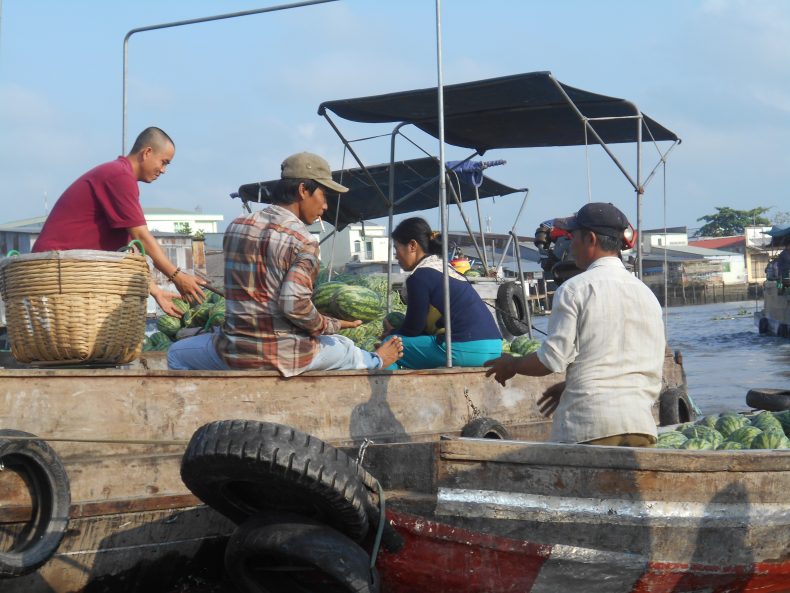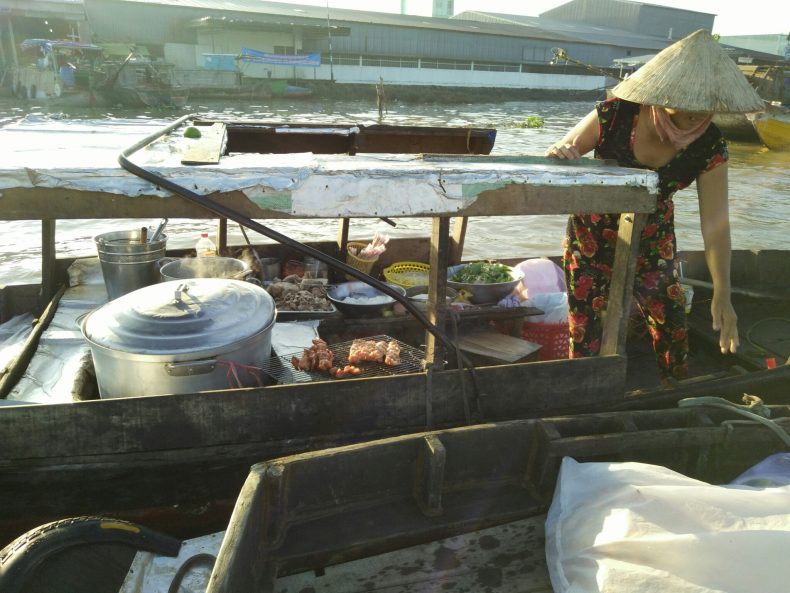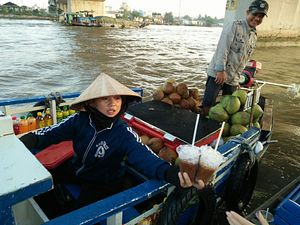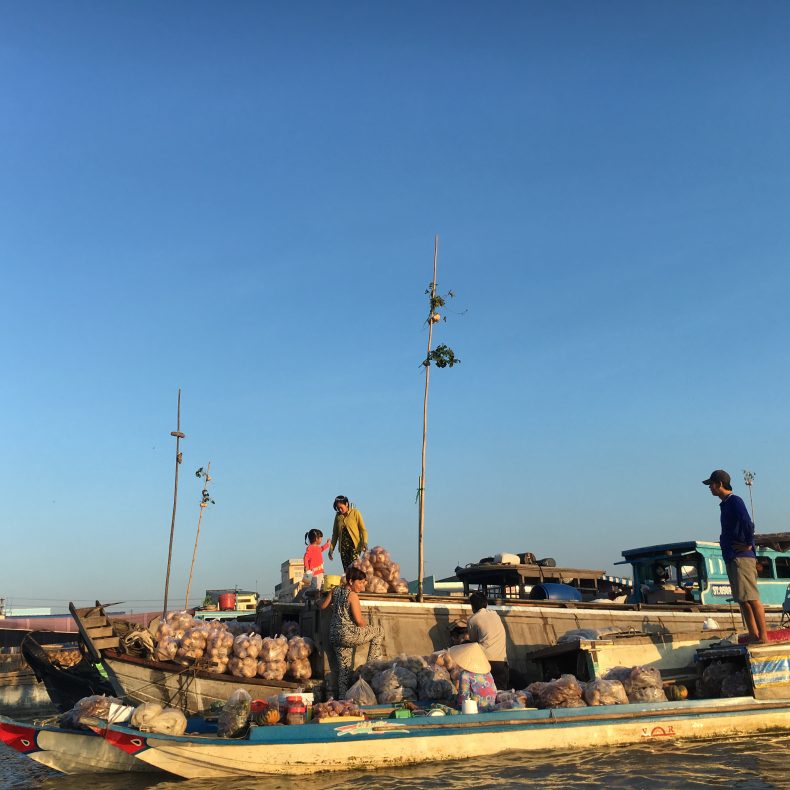Amid mighty rivers and dense mangroves, the busy floating markets in Vietnam’s Mekong Delta have long shaped the delta’s well-known “water civilization.” As many as a dozen floating markets still remain along major waterways around the delta, where boats, houses, and markets float upon the maze of rivers, canals, and arroyos that criss-cross the landscape like arteries. No one knows exactly how old the delta’s floating markets are, but some historians believe they have flourished since the Nguyen Dynasty in the early 19th century. Since then, they have long been major markets, sustaining thousands of floating lives.
In the Vietnamese floating markets, hundreds of boats and sampans, full of fruit and vegetables, flowers, and handicraft products, gather to trade their various goods, making for crowded and frenetic scenery. The bustling commerce of these “floating towns” stands in contrast to the languid and quiet lifestyle in the countryside along the river banks. More importantly, however, the cultural and historical values that the markets reflect are considered a key to understanding the Mekong Delta inhabitants’ identity and traditions.

People exchange goods from boat to boat at one of the floating markets in the Mekong Delta. Image by Dao Ngoc Canh.
The Delta’s Water Civilization
Many ethnically-diverse groups of people migrated to the Mekong Delta from Northern and Central Vietnam, China, Cambodia, and the Malay Peninsula in pre-colonial times. Through trading activities and interactions in the floating markets, they gradually mixed their different cultures into a harmonious common whole, although some aspects remain distinct. In this respect, the delta’s floating markets are “melting pots” which have experienced the fusion of nationalities, cultures, and ethnicities for centuries.
Despite centuries of cultural borrowing and sometimes foreign conquest, the delta people rarely became carbon copies of their mentors (or invaders). Rather, they took ideas they wanted from outsiders and adapted them, creating a synthesis. As seen from their sampan-building techniques, indigenous religion (for example, Đạo Hòa Hảo or Hoahaoism), clothing, and food habits, the local inhabitants have deftly synthesized and localized outside concepts to create their own variations. Áo bà ba, a traditional costume most commonly worn by ordinary Mekong Delta people in the past and still commonly worn today by saleswomen, combines the designs of tunics introduced by Chinese exiles and Malay seafarers. Bún nước lèo – rice noodle soup with fermented fish, roast pork and seafood – the delta people’s most-preferred dish for breakfast, was developed by mixing three recipes from Khmer, Vietnamese, and Chinese cuisine. These products of cultural fusions are among the most popular and unique things visitors see and experience at the Mekong Delta’s floating markets.
Given the fact that the low-laying delta frequently floods, staying afloat (literally) is an inevitable part of life for local businesses. Traders creatively innovate their boats to sustain family life on the water while doing business. They manage to live on the river; many link their lives with their houseboats for generations. Those floating families and attendant lifestyles and religious beliefs are distinct characteristics of the markets.
The floating markets are major wholesale markets in the delta. As early as 4 am, hundreds of big boats and sampans come to anchor along the riverbanks, forming a line stretching for up to two kilometers. Business here begins at the crack of dawn, when the weather is still cool, and trails off around 9 am. Owners of large boat bring in whatever they want to sell –from handicrafts, pottery, and ceramics, to tropical fruits, domestic animals, poultry, snakes, and bonsais — from villages as far as tens of kilometers away.
By sunrise, the markets are clogged with the sampans of marketeers and customers. Since space is tight and surrounding traffic doesn’t stop, speed is a must for transactions on the water. Shoppers come by land and water. As they stumble from boat to boat, they often interrupt their shopping to enjoy bowls of bún nước lèo prepared, rather alarmingly, on open fires in special “fast food” sampans or beverages in smaller rafts serving as mobile cafés. There are also other businesses amid the swarm of boats: hairdressers and herbalists, and even lottery ticket salesmen, who can hardly keep up with demand.

A “fast food” sampan prepares food for hungry traders and customers at the floating market. Image by Dao Ngoc Canh.
As smart business owners everywhere know, sales in the floating markets go better with a friendly smile and even advertising: vendors often hoist a sample of their wares, like pumpkins, pineapples, cucumbers, and garlic, on a bamboo pole, known as cây bẹo in the local dialect. Hundreds of such poles, decorated by colorful fruit and vegetables, point skyward. Together with boisterous brouhaha of laughter and talk, the floating markets make a picturesque spectacle – one that looks like a festival.
Living in cramped houseboats means a lack of facilities, including limited access to school and healthcare, but owners do have convenient access to the water upon which they completely rely for their subsistence. Such a nomadic life further challenges and teaches them, and their children as well, how to adapt and get on smoothly with a new environment, especially when nature tries to take back the neighborhood. Correspondingly, they have accumulated experience and built up indigenous knowledge and wisdom on how to properly exploit nature as well as adapt to changing circumstances.
Fading Cultural Treasures
For centuries, the floating markets have witnessed the twin process of state-formation and state-building in the delta. They have remained unchanging for generations, surviving Siamese, French, and American conquerors come and gone, followed by the Communists, who fought a number of water wars here and left the slice of capitalism found in the markets alone during the pre-Doi Moi period.
Yet, the markets are now profoundly changing. A decade ago, Cai Rang floating market – the biggest in the delta – stretched nearly two kilometers along a confluence where Cai Rang River empties into the Hau River (a major distributary of the Mekong River in Vietnam). Today, the market’s size is half that. Vietnamese tourists, especially those from northern Vietnam, come to see this fading part of the region’s age-old floating markets — but the survival of these markets is at stake.
To make life better for the people of the Mekong Delta, there is a push for progress, but progress might just push these markets into extinction. For generations, local dealers have lived on houseboats, moving between fields and villages to collect and purchase farmers’ harvests before transferring them to the market through the intricate network of free-flowing waterways. But starting in the 1990s, the government decided to mobilize delta farmers to build extensive river dikes and sluice gates to control the annual floods. This anti-flood policy made it possible to harvest two or even three crops a year in the delta’s former wetlands. But it at the same time has had irreparable impacts on the environment and ecosystems, preventing the wetlands from being enriched by annual inundations. After the dike systems were completely built in the mid-2000s, they also appeared to obstruct intra-regional river traffic – traders can no longer freely move their boats to the floating markets. Many had no choice but to change their livelihood.
More challenging is that the rapid pace of urbanization in the delta, followed by the booming expansion of transportation infrastructure and the proliferation of modern supermarkets selling goods in air-conditioned comfort, has quickly overwhelmed the role of floating markets and river traffic in general. Expanding networks of bridges and roads mean trucks, not boats, bring in goods, and shopping is about navigating traffic-jammed roads rather than rivers. The current situation has many alarmed that the floating markets have reached their sell-by date.
Mai Thi Mung, 48, a former houseboat-based trader, remember how her family lived a floating nomadic lifestyle before they gave up on staying afloat three years ago. The harsh living conditions, such as a lack of electricity, fresh drinking water, and education opportunities, prevented them from keeping up with the time.
“Staying afloat is a good way, though boring, for those who love nature… But life was very hard back then,” Mung said. “Now every dealer prefers transporting goods and vegetables by vehicles since they are much more convenient and faster than boats. Only those who can’t manage to live ashore still remain afloat.”
Mung is among thousands of former floating traders in the delta who have decided “go ashore” and move forward with off-river activities such as working in construction sites and factories. But for them, their past – living, shopping, selling, and eating aboard boats, where they met new friends and learned new customs when traveling – remains memorable.
“Boating on the streams around the Mekong Delta made traders like us more receptive and open-minded. We have learned everything new, from local units of measurement, dialects, recipes, to wedding and funeral customs since they vary from province to province,” said Hai Cong, Mung’s husband.
New Promises and Challenges
The floating markets are no longer crowded and are likely to become even more desolate in the delta’s new era. But there is something else changing, and maybe it’s not a bad thing to those who still have a strong attachment to their lifestyle afloat. A rapid growth in the region’s tourism has greatly contributed to rising income and opportunities in the markets. Most of the existing floating markets, especially those in Cai Rang (Can Tho City), Phung Hiep and Nga Bay (Hau Giang province), and Cai Be (Tieng Giang province), now appear to be “must-see” tourist destinations, attracting an estimated 500-700 visitors every day, most of them from abroad.
Some travel agencies in Vietnam include floating market visits in their itineraries and actively collaborate with local vendors and boat owners to offer services to tourists. In the process, what was once a common way of life in the Mekong Delta has swiftly turned into more of a novelty form of entertainment. Local food that is cooked and served directly from a floating boat and inexpensive fruit shopping are the biggest attractions to every floating market. Some foreigners also enjoy navigating the markets on personal boat tours given by former floating traders.
However, another danger appears to challenge the prospects of tourism. Whereas Thailand and Indonesia have successfully developed regular community-based tourism in their floating markets, leaders in Vietnam’s delta provinces still struggle to prevent floating traders and residents from their old-fashioned habit of dumping all types of rubbish, from vegetable peels to nylon bags and foam boxes, in the water — and relieving themselves in the river as well. Local experts warn the markets will no longer be tourist draws if pollution issues are not fixed. Unfortunately, local leaders have had little luck addressing the problem so far.
“Their habit of discharging human waste directly into the river is not easy to change,” said Nguyen Duy Minh, director of the Cai Rang District Tourism Center. “We once built a public restroom on a raft but locals refused to use it,” he added.
Nguyen Trong Nhan, a lecturer focusing on Mekong Delta tourism at the School of Social Sciences and Humanities, Can Tho University, suggests that to make the floating markets more attractive, local authorities will have to improve environmental protection, rearrange the mooring system for boats, and diversify the goods and services offered to tourists.
“The floating markets remain important to local economic growth but in terms of tourism, not in trade,” he said. “Thus, the local authorities must acknowledge this fact to re-arrange the market’s activities to fit better with tourists’ demands and tastes.”
Final Thoughts
In today’s era of globalization, the Mekong Delta people’s tastes and shopping habits have significantly shifted to favor the high-rise trade centers equipped with state-of-the-art facilities mushrooming around the delta. The quaint floating markets, therefore, appear too obsolete to compete – both locally and internationally. However, they could still play a role as a way to remember the delta’s history. To that end, the traders staying afloat here have begun to change by proactively engaging, to varying degrees, in local tourism development.
But the changes coming to the markets, even though it may lead them to ruins, are not always bad things for the people involved. Older generations of houseboat owners, like Hai Cong and his wife, never attended school and lagged behind as a cost of staying afloat. Now, they are likely to become the last generation forced to live on boats and be always on the move. They sweat and struggle with a single hope that their descendants will have a better life: finishing high school and getting better jobs with sustainable incomes. And that hope may be the last real chapter here, because a better future for the next generation will surely mean an end to these age-old markets that once thrived on the ebb and flow of the mighty rivers that both divide and connect the Mekong Delta.
While Vietnam’s policy planners still fumble for the right way to sustain these culturally rich markets, community-based tourism appears to be possible salvation for local traders and other economic stakeholders. Recent years have seen increasing reputations for the delta’s floating markets, attested by an increase in the number of tourists coming to visit year after year. But prominent dangers, including environmental pollution and poor governance, remain unsettled, challenging any attempts to preserve the markets.
Local leaders should enable civil society groups to take part in community education and capacity building since they can better address challenges that government sometimes cannot solve by itself. Also, Vietnam could learn from Bangkok’s floating markets to develop a tourism-oriented floating market paradigm in its Mekong Delta.
Nguyen Minh Quang is a lecturer at the School of Education, Can Tho University. His recent publications look at Sino-Vietnamese bilateral ties, contemporary conflicts in Southeast Asia, and environmental issues and hydropolitics in the Greater Mekong Subregion, including Vietnam’s Mekong Delta.
Dao Ngoc Canh, Ph.D. in geography, is a senior lecturer and deputy dean of the School of Social Sciences and Humanities, Can Tho University. His research focuses on Mekong Delta tourism and Vietnam’s human geography.



































